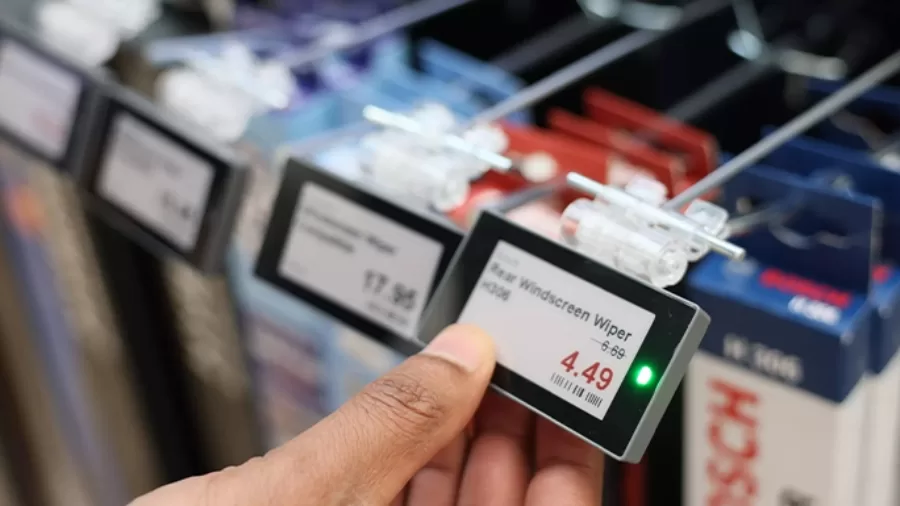Is This the End of Weekly Prices? Inside the Real-Time Grocery Store

- Electronic shelf labels (ESLs) are enabling supermarkets globally to change prices multiple times per day.
- Consumers and brands are responding to a new retail model where price consistency is no longer guaranteed.
Step into a REMA 1000 store in Norway, and one feature stands out quickly: the digital shelf tags. The ESLs are tied to one central price engine, which enables the prices to change without intervention from an employee.
REMA 1000 stores reportedly make up to 2,000 price changes daily in different sections of the store during certain times of the year. Even though there are variations depending on the individual item, most changes in the stores are markdowns occurring during open hours, while major resets, including price increments, are done overnight. This shift reflects a major departure from traditional retail operations, which typically involve static prices printed on paper labels, changed weekly or less frequently.
What Makes This Model Different from Traditional Supermarket Pricing?
In the conventional model, supermarkets sell products at fixed prices, which are decided over days and weeks; these are manually changed and updated whenever required. Usually, the promotional sales are planned weeks, with the secondary promotion implemented through printed shelf labels.
ESLs eliminate that manual burden. Pricing teams can now:
- Adjust prices centrally and in real time.
- React to surplus inventory and expiration cycles
- Conduct time-bound or location-based promotions
- Benchmark against competitor prices dynamically
Global Rollout: Beyond Scandinavia
Albert Heijn, a major grocery chain in the Netherlands and Belgium, applies scheduled markdowns to products nearing expiration. Discounts increase in stages—from 25% to 40%, 70%, and up to 90%—as items approach the sell-by date. According to published figures, Albert Heijn’s dynamic pricing systems contribute significantly to reducing food waste, reportedly by hundreds of thousands of kilograms annually.
In the United States, major grocers including Walmart, Whole Foods, and Kroger are testing or deploying ESL systems. These initiatives primarily aim to reduce operational costs—particularly labour and paper waste—not implement real-time price surging.
A 2024 study from the University of California, San Diego, analysing 180 million product-level data points, found no increase in surge pricing after ESL adoption. The incidence of products showing any surge pricing behaviour fell to 0.0006% post-installation.
Are UK Retailers Joining the Trend?
Tesco has confirmed ESL pilots in select UK locations. While direct confirmation from Sainsbury’s and Asda is limited, industry momentum suggests multiple UK retailers are exploring or trialling the technology.
UK grocers have publicly stated that any ESL-driven pricing changes occur outside of open hours, mainly to reflect supply conditions and promotional cycles. At present, there is no evidence that dynamic price increases are being applied during customer visits in the UK.
What This Means for Consumers
For shoppers, ESLs represent a departure from the static pricing model they’re accustomed to. Prices may shift within hours, even on everyday staples. While most in-store adjustments are markdowns, the unpredictable nature of pricing can impact shopping behaviour and perceived fairness.
In countries like Norway and the Netherlands, retailers focus on transparency, communicating clearly that price changes serve to reduce waste or support better stock rotation. Signage and mobile alerts are often used to clarify why and when changes happen.
What This Means for Brands
For manufacturers and brands, dynamic pricing introduces new challenges. Fixed promotional campaigns can become misaligned with in-store pricing. Consistent brand value propositions may be undermined by frequent fluctuations in perceived cost.
Key considerations for brand managers include:
- Real-time monitoring of SKU-level pricing across locations
- Awareness of regional or time-based pricing variations
- Adjusting trade promotion timing and messaging to fit retailer models
- Maintaining customer trust amid visible price movement
Strategic Steps Brands Should Take Globally
- Use retailer pricing data. Request access to ESL change logs where possible.
- Audit field compliance. Ensure in-store conditions reflect national or regional campaigns.
- Avoid time-bound static pricing claims in ads. Confirm shelf consistency before marketing promotions.
- Collaborate on shopper communication. Help retailers explain dynamic pricing to consumers.
- Segment SKUs by pricing flexibility. Identify which items tolerate volatility and which require fixed pricing.
What Comes Next?
Research from Polaris Market Research suggests that the ESL market will grow significantly in Europe and North America by 2030, driven by labour pressures, digitisation, and sustainability goals. While specific UK projections vary, the underlying shift toward dynamic pricing infrastructure is widely expected.
This change does not represent a minor evolution—it signals a structural realignment in how prices are set, presented, and perceived in physical retail.
Supermarkets are beginning to behave more like digital marketplaces. Brands and consumers will need to adapt accordingly.











